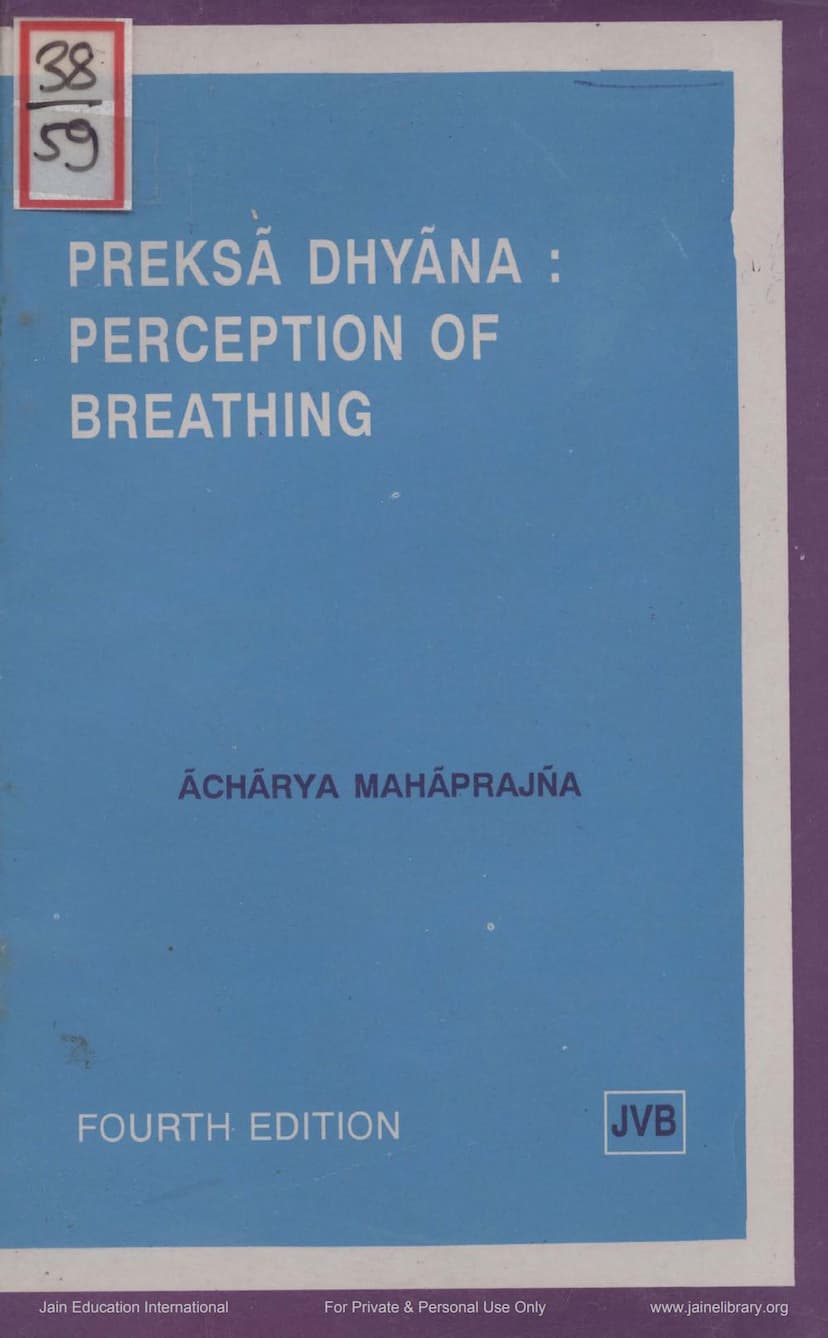Preksha Dhyana Perception Of Breathing
Added to library: September 2, 2025

Summary
Here's a comprehensive summary of "Preksha Dhyana: Perception of Breathing" by Acharya Mahaprajna:
Core Philosophy and Purpose:
"Preksha Dhyana: Perception of Breathing" is a booklet from the "Science of Living Series" that introduces a profound Jain meditation technique focused on the mindful observation of breathing. Its primary aim is to achieve attitudinal change, behavioral modification, and integrated personality development. The book bridges ancient Jain philosophy with modern scientific understanding, offering a path to overcome the stress and psychosomatic diseases prevalent in today's technologically driven world. It emphasizes harnessing the inherent powers within oneself for peace and happiness.
The Significance of Breathing:
The book underscores the fundamental connection between breathing and life itself, stating, "To Breathe is to live." Breathing is identified as the primary source of vital energy (Prana) that animates all bodily functions, the mind, and even consciousness. Proper breathing is presented as the crucial first step to unlocking latent energies and achieving spiritual development.
Breathing: A Philosophical and Scientific Perspective:
- Philosophical: Breathing is viewed as a spiritual energy generator, a bridge connecting the body, mind, and vital energy. Perception of breath is seen as a way to "see thyself" and realize the subtle aspects of consciousness. Breath is considered a pure, natural, and inherent medium for this self-awareness.
- Scientific: The book details the physiological process of respiration, explaining the role of the respiratory system, gas exchange in the alveoli, and the muscles involved in breathing. It highlights how scientific "complete breathing" – slow, deep, and rhythmic – optimizes oxygen intake and carbon dioxide expulsion, leading to better physical and mental health.
The Problem of Modern Life and the Solution:
The "Age of Tensions" characterized by industrialization and over-urbanization leads to immense stress, resulting in psychosomatic illnesses. While superficial remedies like drugs offer temporary relief, Preksha Dhyana offers a path of "catharsis and development of inherent powers." It teaches that life's processes are controllable through the spiritual self, and proper living, including breathing, is key to this control.
What is Preksha Dhyana?
Preksha Dhyana is a technique of meditation that involves perception (Preksha) of various internal phenomena. The book focuses on Shvasa-Preksha (Perception of Breathing) as the foundational practice. Other methods mentioned include perception of the body and psychic centers. The core principle is to engage the mind in focused observation, leading to internal transformation and the pacification of negative emotions like anger and fear.
Why Breathing as the Object of Perception?
Breathing is chosen as the object of perception because:
- It is a function that can be controlled voluntarily as well as autonomically.
- It is a bridge between the internal and the external.
- It is a natural, inherent, and ever-present event of the present moment, helping to anchor the mind.
- Focusing on breath helps still the wandering mind by engaging it in perception rather than thought.
Types of Shvasa-Preksha:
The book details two primary techniques for the perception of breathing:
- Dirgha Shvasa Preksha (Perception of Deep Breathing): This involves regulating breathing to be slow, deep, continuous, and rhythmic, often focusing on the movement of the abdominal muscles or the sensation at the nostrils. It aims to reduce tension and promote mental concentration.
- Samavrtti-Shvasa Preksha (Perception of Alternate Breathing): This technique involves consciously alternating breathing through the right and left nostrils, often with the use of fingers initially, and later through willpower. It is believed to balance the autonomic nervous system and enhance perceptual abilities. The book also introduces a variation that includes breath retention (Kumbhaka).
Techniques and Practice:
The book provides step-by-step instructions for practicing Preksha Dhyana, including:
- Posture (Asana): Emphasizing a steady, comfortable, and erect posture.
- Hand Position (Mudra): Suggesting specific hand placements for concentration.
- Relaxation (Kayotsarga): A crucial preparatory step involving progressive relaxation of the entire body to eliminate muscular tension.
- Internal Trip (Antaryatra): Directing conscious attention along the spinal cord to generate nervous energy and weaken psychological distortions.
- Recitation of Mantras: Suggesting the use of "Arham" or "Mahaprana Dhvani" to enhance the meditative experience.
- Specific Breathing Exercises: Detailing the techniques for complete breathing, deep breathing, and alternate nostril breathing.
Benefits of Preksha Dhyana (Perception of Breathing):
The practice offers a wide range of benefits:
- Mental Happiness: A profound sense of happiness, distinct from fleeting joy.
- Concentration and Operational Efficiency: Improves focus, leading to increased productivity and effectiveness in all aspects of life.
- Alertness: Sharpens mental awareness, preventing the mind from wandering.
- Equanimity: Fosters emotional stability by reducing the impact of like and dislike, attachment and aversion.
- Purity of Perception: Cleanses perception from emotional biases, allowing for clearer understanding and realization of truth.
- Energy Generation: Activates primary sources of bio-energy, leading to increased vitality and the potential for higher states of consciousness and even extra-sensory perception.
Accessibility and Guidance:
The book emphasizes that Preksha Dhyana is a universal technique accessible to anyone, regardless of background. However, it stresses the importance of learning from experienced teachers. It also mentions the establishment of training centers for comprehensive learning.
In essence, "Preksha Dhyana: Perception of Breathing" serves as an accessible guide to a powerful meditative practice that harnesses the fundamental process of breathing to achieve mental clarity, emotional balance, physical well-being, and ultimately, spiritual growth.